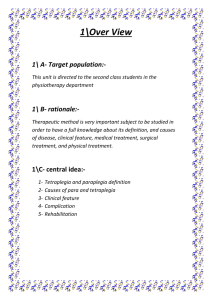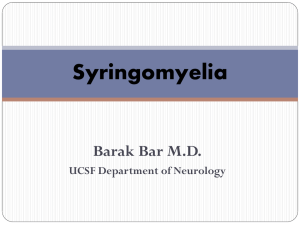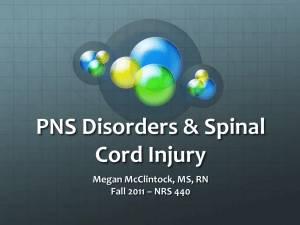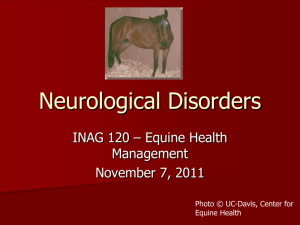Hyperlipidemia - Weber State University
advertisement
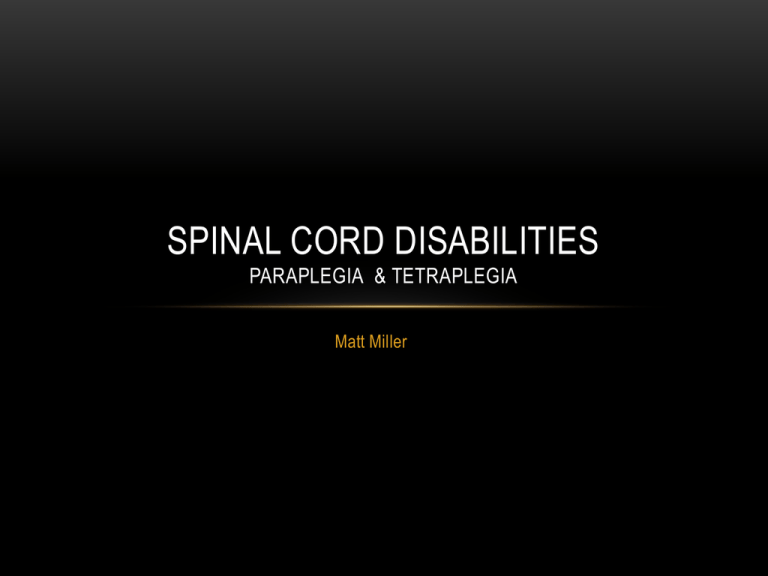
SPINAL CORD DISABILITIES PARAPLEGIA & TETRAPLEGIA Matt Miller WHAT IS IT? • Spinal Cord Disabilities frequently result in paraplegia or tetraplegia, with segmental neuromuscular, autonomic, and physiologic impairment of the legs, arms, and/or trunk. • Paraplegia- paralysis of both lower limbs due to spinal disease or injury. “Paraplegia results when an injury to the spinal cord is below the first thoracic spinal nerve. This results in the loss of feeling and movement, to some degree, of the legs. Paraplegics can experience anything from impairment of leg movement to complete loss of leg movement all the way up to the chest. Paraplegics are able to move their arms and hands.” • Tetraplegia- (Also known as Quadriplegia) paralysis of both lower limbs and upper extremities due to spinal disease of injury. “The primary cause of quadriplegia is a spinal cord injury, but other conditions such as cerebral palsy and strokes can cause a similar appearing paralysis. The amount of impairment resulting from a spinal cord injury depends on the part of the spinal cord injured and the amount of damage done .” EPIDEMIOLOGY • Most traumatic spinal cord injuries (SCIs) result from motor vehicle accidents and falls(42.1%), with fewer caused by sports, violence, infection or tumor, or surgical complications. • Incidence of new traumatic SCIs is approximately 32 per million population. • Estimated 8,000 new SCIs per year, and approximately 75,000 total SCI survivors in any given year. • 1 in every 1,000 live births in the U.S. results in spina bifida (congenital developmental form of spinal cord disability)* (4,000 per year) • Approximately 259,000 people living in the U.S. have SCI • 80.9% of SCIs in the U.S. have occurred among males. • Average age of SCI is 40.2 years. UNDERSTANDING • http://www.youtube.com/watch?v=PseUxltIw_U TYPES & CAUSES OF SPINAL CORD DISABILITIES • Paraplegia - Injury in the spinal cord in the thoracic, lumbar, or sacral segments, including the cauda equina and conus medullaris • Tetraplegia - Injury to the spinal cord in the cervical region, with associated loss of muscle strength in all 4 extremities SCIs can be sustained through a variety of mechanisms, including: o Destruction from direct trauma o Compression by bone fragments, hematoma, or disk material o Ischemia from damage or impingement on the spinal arteries • Spina Bifida - involves incomplete development and closure of the vertebral arch, resulting in spinal cord damage and can cause low-level paraplegia. • Congenital and acquired or traumatic spinal cord disability can result in the same sensorimotor, autonomic, physiological, and locomotor impairments. SYMPTOMS • Spinal cord disability from any etiology results in impairment or loss of sensorimotor and other functions in the trunk or extremities caused by damage to the neural elements within the spinal canal. • SCI: Cervical Segments (C1-C8) – causes tetraplegia, with impairment to the arms, trunks, legs, and pelvic organs. (bladder, bowels, sexual organs) • • Breathing difficulties (from paralysis of the breathing muscles) • Numbness and/or pain • Spasticity (increased muscle tone) Thoracic Segments (T2-T12) – causes paraplegia, with impairment to the trunk, legs, pelvic organs or both. • Loss of bladder & bowel control • Numbness and/or pain • Spasticity SYMPTOMS (CONTINUED) • Lumbar or Sacral Segments of the cauda equina (L1 –L5, S1-S4) – causes impairment to the legs or pelvic organs or both. The neurological level and completeness of injury determine the degree of impairment • Loss of bladder & bowel control • Numbness and/or pain • Spasticity http://www.spineuniverse.com/anatomy/thoracic-spine SYMPTOMS (CONTINUED) • With any SCI, physiological impairment may include extensive muscular paralysis and sympathetic nervous system impairment. • Reduced ability to voluntarily perform large muscle group aerobic exercise. • Inability to stimulate the cardiovascular system to support higher rates of aerobic metabolism • Common secondary complications during exercise (especially in individuals w/tetraplegia) may include: limited positive cardiac chronotropic and inotropic states, excessive venous pooling, orthostatic and exercise hypotension, exercise intolerance, autonomic dysreflexia, headache, bradycardia, flushing, gooseflesh, unusual sweating, shivering, and nasal congestions. TESTING SCIs are medical emergencies requiring immediate attention. After an SCI, the health-care provider will perform a battery of tests, including a neurological exam to determine the exact location of the injury. • Some reflexes may be abnormal or even absent, once swelling goes down some reflexes may slowly recover. • The following tests are likely to be ordered: • A CT scan or MRI of the spine may show the location and extent of the damage and reveal problems such as blood clots (hematomas). • Myelogram (an x-ray of the spine after injection of dye) may be necessary in rare cases. • Somatosensory evoked potential (SSEP) testing or magnetic stimulation may show if nerve signals can pass through the spinal cord. • Spine x-rays may show fracture or damage to the bones of the spine. TREATMENT SCIs require immediate treatment to reduce the long-term effects. The time between the injury and treatment is a critical factor affecting the eventual outcome. • Surgery may be needed to • remove fluid or tissue that presses on the spinal cord • remove bone fragments, disk fragments, or foreign objects • fuse broken spinal bones or place spinal braces TREATMENT (CONTINUED) Today, many new options are offering quadriplegia patients new hope. One of these options is called Functional Neuromuscular Stimulation (FNS). FNS stimulates the intact peripheral nerves so that the paralyzed muscles will contract. The contractions are stimulated using either electrodes that have been placed on the skin or that have been implanted. • An implantable FNS system has been used to help people with some types of spinal injury regain use of their hands Tendon transfer is another option which allows some people with quadriplegia more use of the arms and hands. This complicated surgery transfers a nonessential muscle with nerve function to the shoulder or arm to help restore function. • FNS may be used in conjunction with tendon transfer. MANAGEMENT & MEDICATIONS Management of individuals with paraplegia or tetraplegia is complex because of the multitude of complications associated with their particular SCI, which include the following: • Skin – individuals with spinal cord disability should avoid sitting for long periods without pressure relief. • Bones – those working with spinal cord patients should avoid dropping during transfers or allowing the person to fall, as they are at increased risk of fractures secondary to osteoporosis. • Stabilization – Sufficient strapping and seat belts should be used during upright exercise • Bladder/ Bowels – Individuals with SCI should empty their bladder or leg bag just before exercise testing to avoid bladder bladder overdissention or overfilling of the leg bag, as this could cause autonomic dysreflexia. • Illness – Exercise should postponed if individual is ill (Always!) • Pain – Discontinue upper body exercise that causes pain, as overuse syndromes are prevalent in individuals who use their arms to transfer themselves into and out of wheelchairs. Individual should be allowed to take normal prescription drugs. However should be cautions of drugs that induce either hypotension (ex. Ditropan, Dibenzyline) or diuresis (ex. alcohol, diuretics) • Ideally, corticosteroids should begin as soon as possible after the injury. EFFECTS OF EXERCISE TRAINING • Arm exercise training adaptations are believed to be primarily muscular, increasing muscular strength and endurance of the arm musculature in the exercise modes used. • These may result in 10-20% improvements in peak power output and peak oxygen consumption, as well as enhanced sense of well-being. EXERCISE TESTING • Functional mobility testing such as timed wheeling (6 to 12 min), or a custom-designed mobility obstacle course containing potential environmental barriers such as ramps, stairs, doorways, soft or uneven surfaces, and turns can be beneficial. Involving transfers, lifting, carrying and manipulation of objects is very important. • An environmentally controlled thermoneutral or cool laboratory or clinic should be used to compensate for impaired thermoregulation. • Incremental testing is often used in testing patients with SCI. Heart rate, blood pressure, RPE, symptoms and exercise tolerance should be measured at each stage of testing. • Power output increments may range from 5 to 20 W per stage depending on exercise mode, level, completeness of paraplegia or tetraplegia, and activity and training status. • Common peak power outputs range from 0 to 50 W for those with tetraplegia and from 50 to 120 W for those with paraplegia. • If the individual complains of exhaustion or hypotension is apparent after exercise, leg elevation, rest and fluid ingestion is necessary. EXERCISE PROGRAMMING • Cardiopulmonary training modes may include arm cranking, wheelchair ergometry , wheelchair propulsion on treadmill, swimming, or wheelchair sports, arm-powered cycling, or ambulation with crutches and braces. (for those w/ paraplegia) • To prevent upper body overuse syndromes it is important to vary exercise modes from week to week, strengthen upper back and posterior shoulder muscles, and to stretch anterior shoulder and chest muscles. • The greater the exercising muscle mass, the greater the expected improvements are in physiologic and performance parameters. • In some settings, electrically stimulated muscle contractions can recruit sufficient muscle mass to significantly increase VO2Peak • Improvements are expected to be small (>5% per week). • Individuals with SCI should always be supervised during exercise (especially those w/ tetraplegia). EXERCISE PROGRAMMING TABLE Modes Goals Aerobic • Arm ergometer • Wheelchair ergometer • Wheelchair treadmill • Free Wheeling • Arm cycling • Seated aerobics • Swimming • Wheelchair sports • ESLCE • Strength • Weight machines or dumbbells • Wrist weights Flexibility • Stretching Pg. 302 in text Time to goal • 40-90% VO2R • 3-5 days per week • 20-60 min per session 4-6 months • Increase active muscle mass and strength • Maximize overall strength for functional independence • Improve efficiency of manual wheelchair propulsion • 2-3 sets of 8-12 reps • 2-4 days per week 4-6 months Avoid joint contracture Before aerobic or strength activities 4-6 months • • Increase active muscle mass and strength Maximize overall strength for functional independence Improve efficiency of manual wheelchair propulsion Intensity/Frequency/ Duration REFERENCES • Palmer, Dr. Sarah, Dr. Kay Kreigsman, and Dr. Jefferey Palmer. Spinal Cord Injury: A Guide for • Senelick, Richard, and Karla Dougherty. The Spinal Cord Injury Handbook: For Patients and Families. N.p.: Healthsouth Press, 2010. Print. • Ling GSF. Traumatic brain injury and spinal cord injury. In: Goldman L, Ausiello D, eds. Cecil Medicine. 23rd ed. Philadelphia, PA: Saunders Elsevier; 2007:chap 422. • Dawodu, Segun T. emedicine,medscape.com. Ed. Denise Campagnolo. N.p., 10 Nov. 2011. Web. 22 Mar. 2012. <http://emedicine.medscape.com/article/322480-overview>. • Brainandspinalcord.org. N.p., n.d. Web. 28 Mar. 2012. Path: http://www.brainandspinalcord.org/spinal-cord-injury-types/quadriplegia/index.html. http://www.youtube.com/watch?v=PseUxltIw_U • N.p., 16 June 2010. Web. 2 Apr. 2012. <http://www.ncbi.nlm.nih.gov/pubmedhealth/PMH0002061/>.








